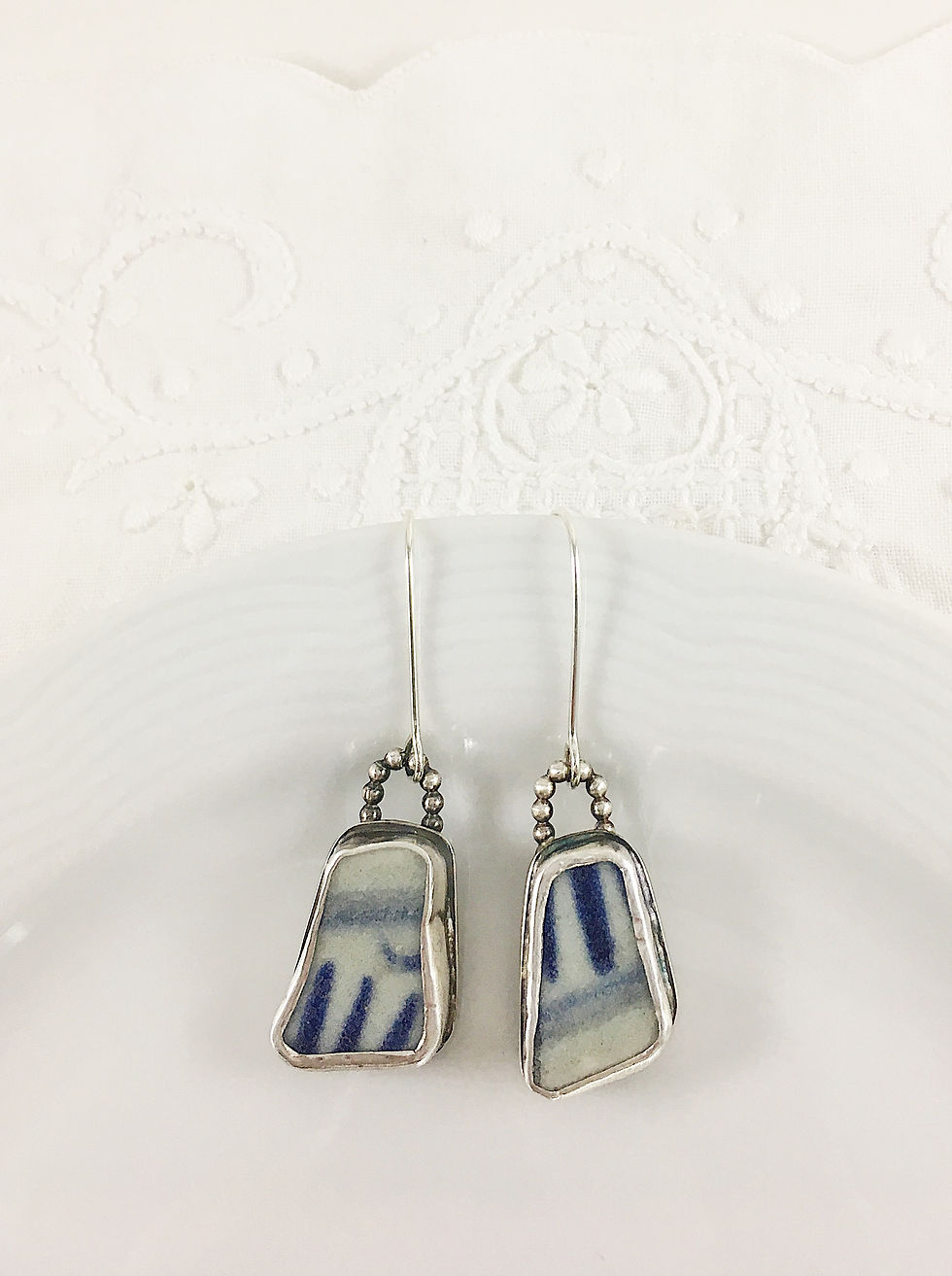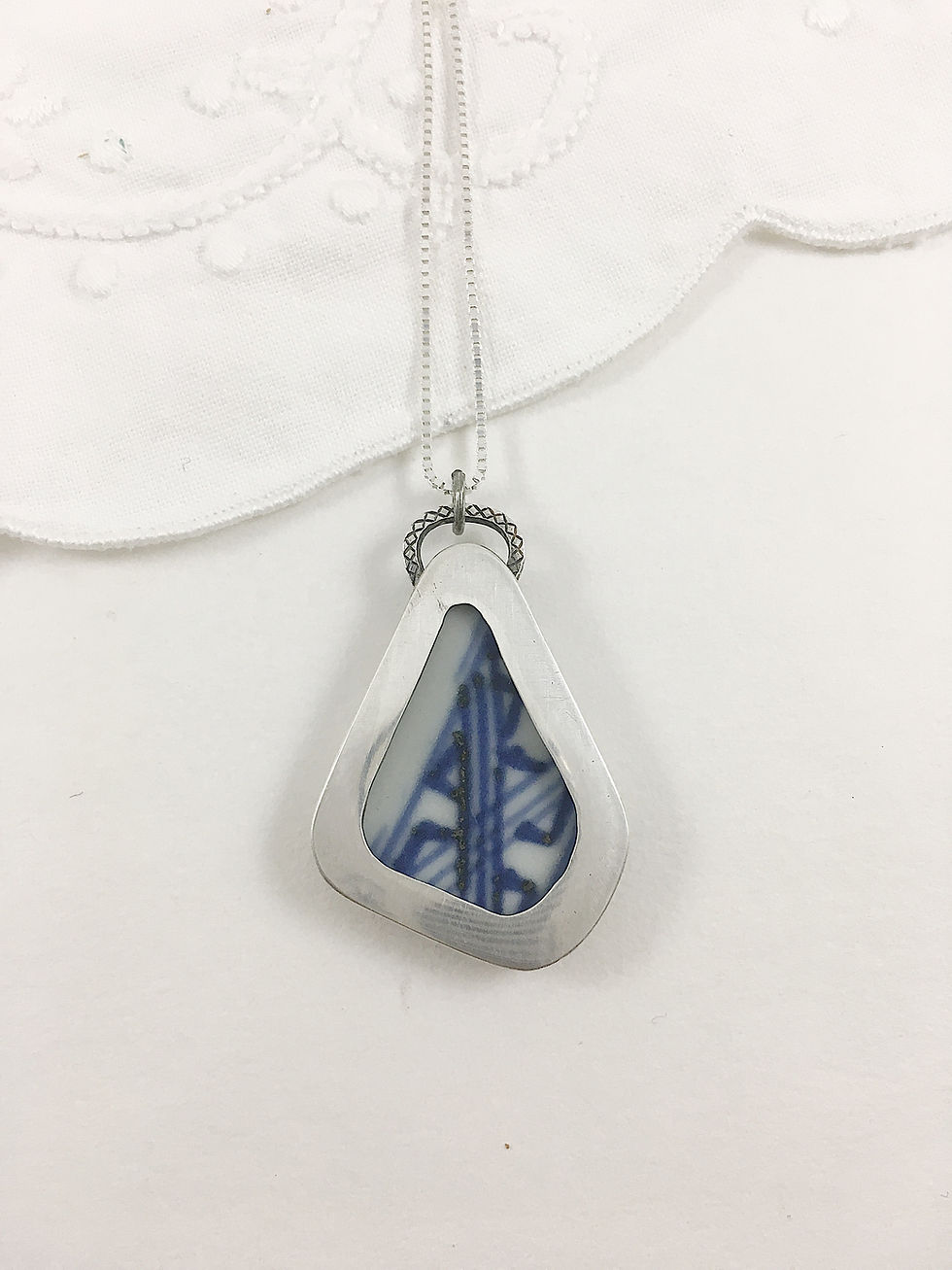Wrecked - creating jewelry with Ming China from an Indonesian shipwreck
- Andi Clarke
- Jan 31, 2023
- 6 min read

A little over a year ago a good friend of mine told me she had some china to give to me for making into jewelry. I do have a bit of a reputation with my friends and customers for working with broken china, and I often get given china shards. Of course I had no idea how special this china actually was or how popular it would prove to be with my customers.
My friend told me it was Ming china and that she’d collected it when she’d scuba dived an old Portuguese shipwreck off the coast of Malaysia where she lived for a period during the 1980's. I was initially skeptical about it being genuine Ming china, but after some internet sleuthing it turned out to be legitimate and genuine.

Here are most of the pieces of Ming china I was given. In this photo I have already cut some of them to be used in pendants and earrings.
Based on the research that I’ve done, it is quite likely this Ming china is about 400 - 500 years old. This type of Late Ming Dynasty china (it's named the Wanlii period) was produced for the European market and was stowed in the hull of the spice ships. It performed three functions - it was ballast for the ship in rough seas, it didn’t matter if it got wet in the hull (unlike spices, teas and silks which needed to be kept dry) and finally there was a market for fine china in Europe as the Europeans only had earthenware for dining on at this period in history. (The skill of making porcelain or china had not been imported to Europe at this stage from, you guessed it, China).
This type of Ming china was called Kraak ware, a name that was derived from the name given to Portuguese trade ships, Carracks. The Dutch East India Company were also doing the same spice trade route and were also transporting Kraak ware to Europe, although credit needs to be given to the Portuguese who discovered the route around Africa. The Dutch were the ones who gave the Ming china the name of Kraak ware. If you look for images of Kraak ware online you will find lots of gorgeous china with designs similar to the pieces that I have used in this range of Ming china jewelry.
Here is a link with additional information about this type off Ming China.
I have created jewelry with the Ming china pieces using my silversmithing skills and various additional tools. I first cut the shards of Ming china and then grind each piece to round out the edges a bit for the intended design.

Here are some of the shards that I've cut and ground ready for being set into sterling silver bezel settings. I have tried to make each one its own unique design, as you will see from the photos of each piece e of jewelry as you continue to read this blog post.

Here are some sketches that I did to help give me clarity on what each piece of Ming china jewelry would look like. I've done some in my signature pendant style (the bottom two) that I've done for years with pebble, sea glass and broken china.
A custom bezel setting is created using sterling silver and I use the shape of the piece of china to dictate to me what type of pendant or earring setting that I will create for it.

Here are some of those designs in process with their individual settings.

Each stage of soldering involves heat, careful placement of sterling silver parts and the solder on flush joints that are being joined and substantial cleaning, sanding and buffing after the joint has been soldered.

I like giving these Ming China jewelry settings an antiqued look by giving it a patina with liver of sulfur. This is then buffed and polished away giving the setting an older look and highlighting additional texture or details that have been added.

These pendants have now had the Ming china placed in them and have been completed by pushing the silver bezel edging over each shard of china. You can see the patina in the top left and bottom right pendants.
As I’ve made each one, I have signed and engraved the number of the piece of jewelry based on the order in which it was made.

If you look really carefully you will see the number "19" engraved on the back of these earrings, authenticating that they were the nineteenth design that I made with the Ming China from the shipwreck.
The next few photos will showcase some designs that I've made with this rare china. If you want to see what's currently available, head to this link in my web shop. It will get you to the general category of my broken china jewelry designs, but the indigo color of the glaze is pretty distinct of this Ming china so you should find them pretty easily.
Ming china pendant no. 9 (Sold)
I unofficially called this one the "rays of sunshine" pendant. Note how I used the design to dictate the setting and pattern on the left of the setting.
Ming china earrings no. 10 - sold
Ming china pendant no. 11
In the interests of almost zero waste and recycling when I make jewelry, I used a left over piece from one of my patterned ring designs and incorporated this off cut in the setting of this pendant.
Ming china earrings no. 14 (Sold)
I love the squiggles in the one shard of china and the rays are the same as the sun ray pendant.
Ming china necklace no. 15 (Sold)
Some of the smaller pieces really lend themselves to more modern horizontal bar necklaces
Ming china earrings no. 19 (Sold)
The back and forth sqiggles of the handmade sterling earwires is another of my signature styles and I often incorporate them in my wire wrapped earrings
Ming china earrings no. 20
These earrings also match the "rays of sunshine" pendant.
Ming china pendant no. 21 - sold
Note both photos of this pendant show the front and the back. Yes, this is a reversible necklace because the Ming china shard had a pattern on both sides, so I sawed a cut out section so that both sides could be enjoyed and to make the necklace more versatile for the person lucky enough to receive it. Patina has been added to this pendant too.

Ming china ring no. 53
I've actually only made a handful of sterling silver rings with Ming china. I have no idea why as it looks really pretty in a setting.

Ming china pendant no.44.
I like adding additional detail to my pendants as it gives additional visual interest to it.
As you will see from the designs above, each is unique in its own right, in fact I’ve had fun making them very different from each other and allowing each Ming china shard to dictate its design. When a customer purchases one of these Ming china jewelry designs, they receive a little write up about the fascinating history of the shipwreck Ming china.
I do have limited pieces of this rare china, so keep checking back on my website to see new ones that I've created and to see which ones are still available. I love the fact that no two pieces of the china will ever be the same, which means that all the jewelry that I make with it will be one of a kind art jewelry pieces and they have an incredible story to them.
A customer at The Olympia Farmers Market pointed out that a very skilled artist had originally painted the beautiful indigo blue designs, then the pieces had been lost for centuries buried in the ocean and now they've been created into art again, just a different form. It's my hope that the original Chinese artists would have approved of how I've recreated their art into these unique jewelry pieces. What do you think? I'd love to hear what you think of this idea or of the designs showcased in this blog post. I can't wait to read your responses in the comments below.











































